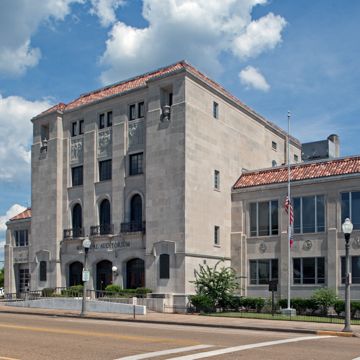The most notable municipal building in the region is this complex structure faced with smooth-cut limestone. Its tripartite massing reflects the building’s varied functions. A central four-story block containing an auditorium is flanked by a pair of two-story wings, one containing a fire station and the other the offices of city hall. An Art Deco flair is exhibited in the overlapping continuous piers articulating the bays of each of the building’s components and in the low-relief sculptures that embellish each facade. Firefighting motifs are featured in medallions on the fire station, whereas those on city hall are government related. The auditorium’s facade exhibits a decorative and even festive air, with three arched entrances with multipaned transoms, three sets of French doors with fanlights opening onto cast-iron balconies on the second story, and three large bas-relief panels over the third-story windows featuring personifications of Civic Duty, Justice, and Prosperity. At the topmost level decorative urns appear in niches of the corner piers.
The building provided the city with much-needed auditorium space for events ranging from local piano recitals to World War II appearances of big bands, and performances by Louis Armstrong, Elvis Presley, and Johnny Cash, among others. In 1956 the auditorium witnessed the first “mixed-race” performance in the city, a musical event entitled The Evolution of Jazz, featuring a band with local African American trumpeter Artis L. Brewster. The auditorium closed in 1977 to make way for increased office space. Although the exterior retains almost all of its original historic fabric, the interior has undergone several major renovations as it continues to function as Texarkana’s governmental center.















